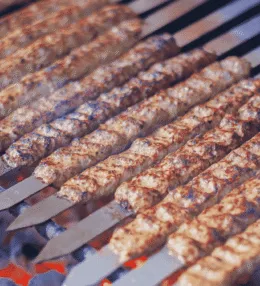
- View
Table of Contents
ToggleRuisleipä, Finland’s iconic rye bread, is more than a daily staple. It is a cornerstone of Finnish food culture, found in homes, school lunches, and even carried in suitcases when travelling abroad. With its dense texture and deep, tangy flavour, it reflects both the landscape and the lifestyle of the north.
Its distinct sourness and hearty bite make it instantly recognisable, while its long shelf life and nourishing quality have kept it relevant through centuries of Finnish history. Whether paired with butter, cheese or cold meats, Ruisleipä remains an essential part of the Finnish table.
Want to dive deeper into Finnish Cuisine? Don’t miss our post on 22 Traditional Finnish Foods to Try
What Is Ruisleipä?
Ruisleipä is a traditional Finnish sourdough bread made from rye flour, using a live starter that gives the bread its characteristic tang and depth. It is typically baked in round, flat loaves with a hole in the centre, a design once used to hang the bread from rafters to dry and store.
Unlike softer wheat based breads, Ruisleipä is dense and robust, made to sustain in harsh winters and long journeys. It is not just food, but fuel, with a bold flavour profile that complements Finland’s minimalist yet deeply rooted cuisine.
Ingredients and Taste
The core ingredients in Ruisleipä are rye flour, water, salt and a sourdough starter. The simplicity of the recipe belies the complexity of its flavour. The fermentation process gives the bread a natural sourness that matures over time, creating layers of earthy, rich taste.
The crust is firm and dark, offering a chewy resistance, while the interior remains moist and tightly packed. Its flavour is bold, slightly acidic and almost malty, making it a satisfying base for open sandwiches or a stand alone snack with a smear of butter.
Different regions in Finland have subtle variations, some including small amounts of wheat flour or incorporating malt for a sweeter tone. However, the core remains unchanged: honest ingredients and traditional fermentation that let the rye speak for itself.
A Taste of History
The origins of Ruisleipä stretch back over a thousand years, long before wheat was common in the Nordic regions. Rye grew reliably in Finland’s cold climate, making it an essential crop for survival. Bread made from rye became a practical solution to harsh winters and limited growing seasons.
In the past, households would bake large batches a few times a year, preserving them by drying and storing them on poles hanging from the ceiling. These ring shaped loaves could be eaten fresh or softened later with milk or soup, making them incredibly versatile.
Through war, famine and migration, Ruisleipä endured. It became more than nourishment; it became a symbol of continuity and resilience. Even today, Finnish children often grow up eating Ruisleipä with their school meals, and many adults abroad still seek it out for a taste of home.
Ruisleipä is not trendy, but timeless. It tells a story of a people who found richness in simplicity, patience in preparation, and pride in tradition. Each slice offers a reminder of Finland’s rugged beauty and the quiet strength of its culinary roots

Finnish Ruisleipä (Rye Bread)
Ingredients
- 250 g active rye sourdough starter room temperature
- 400 ml lukewarm water
- 500 g wholegrain rye flour
- 1 tsp fine sea salt
- Extra rye flour for dusting
- Optional: 1 tsp molasses for deeper colour and mild sweetness
Instructions
- To begin, place your sourdough starter in a large bowl. Stir in lukewarm water using a wooden spoon until evenly mixed. Add molasses at this stage if using, stirring until fully dissolved for a richer depth of flavour.
- Gradually add the rye flour and salt, mixing with a spoon or hands until a thick, sticky dough forms. Do not over knead, rye lacks gluten so the texture will remain tacky and dense. Ensure all flour is hydrated before proceeding.
- Cover the bowl with a damp cloth or cling film and let the dough ferment at room temperature for 12 to 24 hours. Choose a warm and draft free area to encourage proper souring. Longer fermentation yields deeper flavour.
- Once risen and slightly domed with visible bubbles, dust a work surface with rye flour. Turn out the dough and shape it into a round or oval loaf, handling gently to avoid deflating. Avoid kneading, shape with floured hands.
- Line a baking sheet with parchment paper and sprinkle it with rye flour. Transfer the shaped loaf onto it. Cover loosely with a towel and let it rest for another 1 to 2 hours to allow the surface to dry slightly and form a skin.
- Preheat your oven to 220°C. Place an empty metal tray on the bottom rack while preheating. This will be used to create steam, which helps develop a firm crust typical of traditional rye loaves.
- Once ready to bake, score the top of the loaf with a wet serrated knife or razor blade to control cracking during baking. Traditional Finnish loaves often have a single, deep slash across the centre.
- Place the loaf on the middle rack of the oven. Pour a cup of hot water into the preheated tray below to generate steam, then close the oven door quickly. Bake for 15 minutes at 220°C, then reduce heat to 190°C and bake for 35 more minutes.
- Remove the bread and cool it fully on a wire rack before slicing. Serve with butter, smoked fish, or strong cheese. For best flavour and texture, allow the loaf to rest for several hours before cutting. Store wrapped in a cloth at room temperature.
Nutrition
You May Also Like







Leave a Review